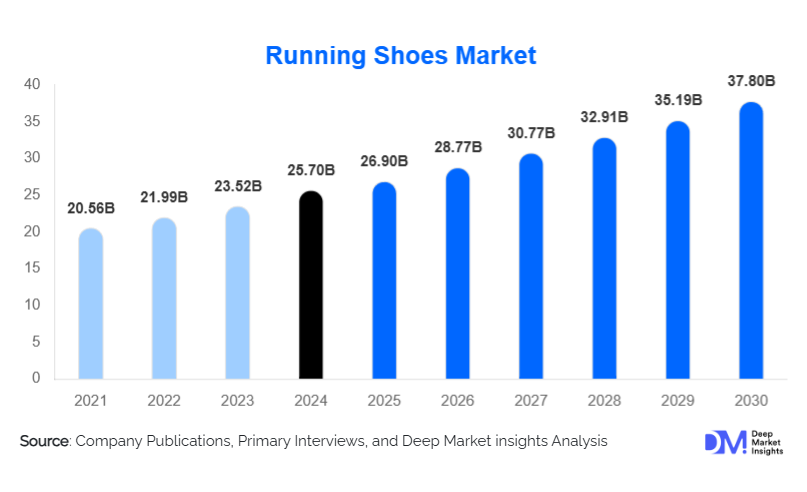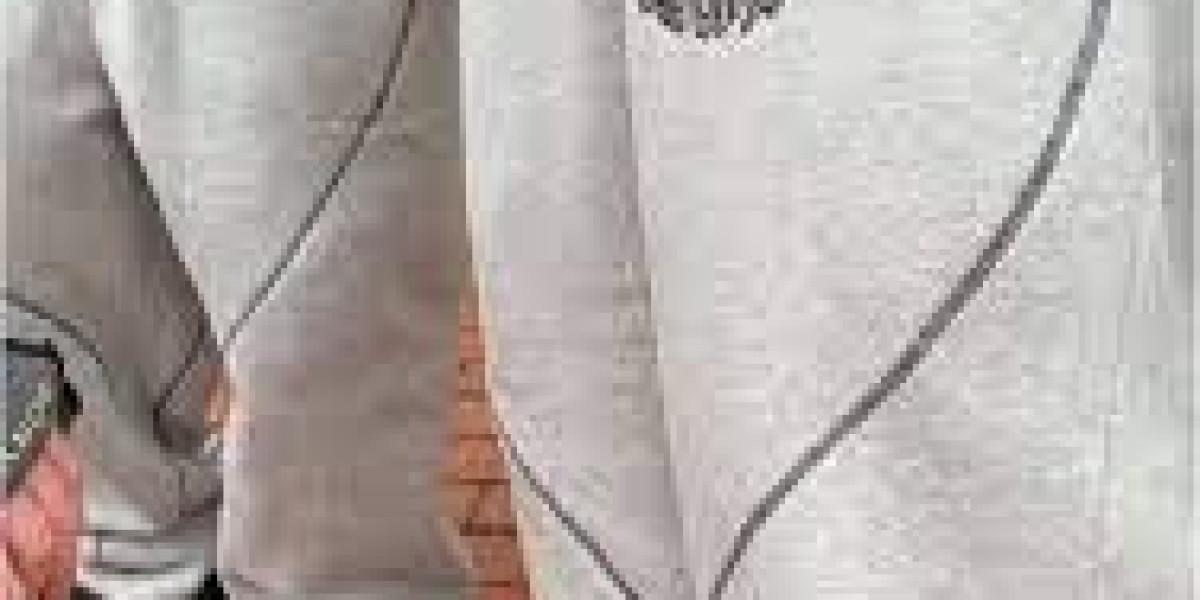Global Running Shoes Market to Reach USD 37.8 Billion by 2030, Driven by Marathon Participation, Fitness Trends, and Product Innovation

According to Deep Market Insights, " The global running shoes market, valued at USD 25.7 billion in 2024, is projected to expand from USD 26.9 billion in 2025 to USD 37.8 billion by 2030, registering a CAGR of 6.95% during the forecast period (2025–2030), according to a recent analysis by Deep Market Insights. Growth is being propelled by rising marathon registrations, increased recreational running participation, and a heightened emphasis on health and fitness across urban populations.
A consumer survey conducted by Deep Market Insights with 1,000 runners revealed that 62% prioritize cushioning and comfort when choosing footwear, while 40% are willing to invest in shoes made from sustainable materials, reflecting changing purchase drivers in the industry.
Market Highlights
-
Market Size & Growth: USD 25.7 billion in 2024; USD 37.8 billion by 2030; CAGR of 6.95%.
-
Regional Leadership: North America leads in 2024, while Europe records the fastest growth.
-
Segmental Insights:
-
Neutral running shoes remain the largest category due to versatility and comfort.
-
Carbon plate shoes dominate premium segments, supported by marathon demand.
-
Trail running shoes gain traction in Europe and North America amid outdoor activity trends.
-
-
Geographic Momentum: The U.S. remains the largest single market, while China and Asia-Pacific lead in growth acceleration.
Key Market Drivers
-
Marathon and Race Participation:
Global marathons such as Boston, Berlin, and Tokyo continue to attract growing participation, while new events in India, China, and Australia drive regional expansion. These trends sustain repeated demand as runners seek specialized footwear tailored to endurance and injury prevention. -
Recreational Fitness Trends:
Urban populations are increasingly prioritizing personal fitness. Neutral and stability shoes are in high demand among recreational runners seeking comfort and injury prevention over competitive performance. -
Product Innovation:
Continuous advances in cushioning systems, lightweight uppers, and energy-return technology are shortening replacement cycles. Innovations such as carbon plates, motion control, and sustainable midsoles are creating differentiation and maintaining consumer interest.
Market Challenges
-
High Retail Prices: Premium models, particularly carbon plate and trail shoes, frequently retail above USD 250, restricting accessibility in price-sensitive markets.
-
Counterfeit and Grey Market Risks: Proliferation of imitation products, especially in Asia and Latin America, erodes brand equity and undermines consumer trust.
-
Sustainability Barriers: While demand for eco-friendly materials is growing, high production costs and limited supply chains hinder rapid scale-up of sustainable products.
Emerging Trends
-
Elite Performance Adoption: Carbon-fiber plate technology, popularized by shoes such as the Nike Alphafly and Adidas Adizero Adios Pro, is now being adopted by advanced amateur runners.
-
Trail Specialization: Rising popularity of ultra-distance and mountain races in France, Spain, and the U.S. is driving demand for shoes designed with improved grip and terrain stability.
-
Sustainability: Brands including Allbirds, Veja, and Hoka are using recycled polyester and sugarcane-based EVA, aligning with regulatory trends and consumer expectations.
-
Digital Engagement: Direct-to-consumer channels, virtual try-ons, and mobile-based customization are reshaping consumer interaction and loyalty programs.
Market Opportunities
-
Emerging Market Expansion: Urbanization and higher disposable incomes in Asia-Pacific and Latin America present new growth avenues for entry-level and mid-tier shoes.
-
Women’s Running Segment: Rising female participation in global races is creating demand for gender-specific footwear designed for biomechanics and style preferences.
-
Direct-to-Consumer Growth: Proprietary e-commerce platforms enable brands to improve margins and respond to consumer preferences through exclusive launches and subscription models.
-
Athlete and Event Collaborations: Sponsorships of marquee races such as UTMB and endorsements from elite athletes are strengthening brand positioning and accelerating adoption of high-performance footwear.
Regional Insights
-
North America: The largest market, driven by marathon culture, recreational running, and high spending power. Trail and carbon plate shoes are in particularly strong demand.
-
Europe: Growth supported by organized races and mountain marathons. Western Europe is leading sustainability adoption in footwear.
-
Asia-Pacific: The fastest-growing market, led by China and Japan, with health awareness and government fitness initiatives fueling demand.
-
Latin America: Brazil and Mexico are emerging hubs, supported by growing middle-class populations and rising e-commerce penetration.
-
Middle East & Africa: Growth concentrated in urban centers such as Dubai, Riyadh, and Johannesburg, supported by increasing disposable incomes and fitness awareness.
Competitive Landscape
Nike holds approximately 27% of the global running shoes market, supported by its Alphafly and ZoomX product lines. Adidas follows with 19%, leveraging its Adizero and Ultraboost series. Other key players include ASICS, New Balance, Puma, Hoka, Brooks, Saucony, Mizuno, Under Armour, Salomon, Skechers, Li-Ning, and Anta Sports.
Recent Developments:
-
March 2025: Nike launched Alphafly 4 with next-generation ZoomX cushioning and an upgraded carbon plate.
-
May 2025: Adidas introduced Adizero Prime X Strung in China, enhancing regional competitiveness.
-
July 2025: Hoka expanded its Clifton series with sugarcane-based EVA midsoles, strengthening sustainability positioning.








